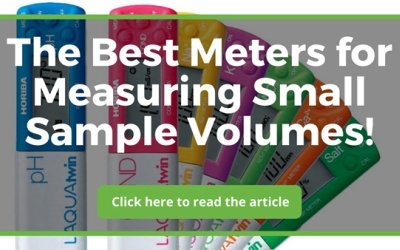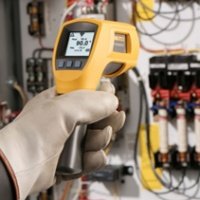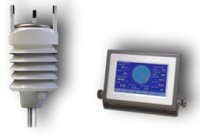The Best Meters for Measuring Small Sample Volumes!

Why Small Volume Meters?
For many applications in laboratories, taking a measurement directly from a sample is not feasible. One difficulty arises when the pH sensor comes directly into contact with a sample where there is contamination. Contamination can be due to an improperly cleaned electrode, carryover of rinsing solution, or reference electrolyte flowing into the sample. In laboratory work, any contamination is unacceptable.
Another challenge is that standard pH electrodes often require a generous sample volume to immerse the electrode completely, which is often impractical.
LAQUAtwin small volume sensors provide elegant solutions to both these problems!
Horiba LAQUAtwin meters employ flat sensor heads to measure tiny sample amounts. Moreover, samples are placed directly onto the flat sensor. No beakers or separate measuring vessels are required!
How Do They Work?
The unique flat sensor found on the Horiba Laquatwin series of water quality meters has evolved over 60 years of engineering advancements. The LAQUAtwin sensors employ the same test principles as standard laboratory electrodes; the difference is that components pack efficiently into a flat sensor chip that's less than 1 mm thick. See figure 1 (below) for an example of the pH sensors flat sensor.

Figure 1 Sectional diagram of the Horiba LAQUAtwin flat sensor
You can employ several techniques to take measurements using LAQUAtwin sensors for a range of needs and applications. Please note: check your sensor model’s manual for exact measurement methods. All the seven methods listed below apply to pH measurement.
- Drops: Place a couple of drops onto the flat sensor. Some of the LAQUAtwin sensors can obtain accurate measurements from samples as small as 0.1mL.
- Immersion: Got plenty of sample material to spare? Open the sensor guard and immerse the sensor.
- Scoop: Scooping is perfect for measurements on the go. Scoop up the water or type of sample you wish to test. This method is great for taking measurements from rivers etc.
- Wipe: Sampling sheets allow tiny, trace volumes to be measured. Volumes can be as small as 0.05mL. An example of use would be to wipe the surface of a person’s skin with a sampling sheet soaked in distilled water and then take a measurement.
- Solid Samples: Solid foods containing moisture can be tested by gently placing a small sample on the sensor.
- Powers: Dry powders can be placed directly on the sensor with an appropriate amount of distilled water to obtain a measurement.
- Paper, Textile, and Film: You can measure various types of paper textiles and films by cutting your sample, placing the pieces directly on the sensor, and then adding a small amount of pure water.
Examples
pH
Here are three Horiba LAQUAtwin electrodes for assessing pH levels in freshwater, aquariums, effluent, soils, food, research laboratories, quality control, and the education sector.
| Specifications | Pocket pH-mV meter with +-0.1 pH accuracy Product Code: pH-11 |
pH 22 LAQUAtwin Compact pH Meter Product Code: pH22 |
LAQUATWIN Compact pH33 pH Meter Product Code: pH-33 |
| Measures: | pH | pH | pH |
| Minimum Volume: |
0.1mL | 0.1mL | 0.1mL |
| Measurement Range: | 0 to 14 pH | 0 to 14 pH | 0 to 14 pH |
| Resolution: | 0.1 pH | 0.01 pH | 0.01 pH |
| Accuracy: | ±0.1 pH | ±0.01 pH | ±0.01 pH |
| Calibration Points (Up to): | Two-points | Three-points | Five-points |
Conductivity
Horiba’s LAQUAtwin series of conductivity meters measure conductivity using a two-electrode bipolar AC sensor. These sensors measure conductivity in the following environments:
- aquariums, soil, and freshwater
- to assess saltwater damage, surface cleanliness, and
- to ensure improved paint adhesion.
| Specifications | Horiba Laquatwin Conductivity Meter Product Code: EC11 |
Horiba Laquatwin Conductivity Meter Product Code: EC-22 |
Horiba Laquatwin Conductivity Meter Product Code: EC-33 |
| Measures: | Conductivity | Conductivity | Conductivity and TDS |
| Minimum Volume: |
0.12mL | 0.12mL | 0.12mL |
| Range and Resolution (Range: Resolution): | 0 to 199 µS/cm, 200 to 1999 µS/cm, 2.00 to 19.99 mS/cm | 0 to 199 uS/cm: 1uScm; 200 to 1999 uS/cm: 1uS/cm; 2.00 to 19.99 mS/cm: 0.01 mS/cm; 20.00 to 199.9 mS/cm: 0.1 mS/cm | Conductivity: 0 to 199 uS/cm: 1uScm; 200 to 1999 uS/cm: 1uS/cm; 2.00 to 19.99 mS/cm: 0.01 mS/cm; 20.00 to 199.9 mS/cm: 0.1 mS/cm TDS 0.0 to 99.9 ppm: 0.1 ppm; 100 to 999 ppm: 1 ppm; 1000 to 9990 ppm: 10 ppm |
| Accuracy: | ±2% full scale | From 0 to 19.99 mS/cm ± 2% full scale, From 20.0 to 199.9 mS/cm ± 5% full scale | From 0 to 19.99 mS/cm ± 2% full scale, From 20.0 to 199.9 mS/cm ± 5% full scale |
| Calibration Points (Up to): | Two-points | Three-points | Three-points |
Other
The following ruggedly-built meters measure specific ions for a host of applications. These include:
- food quality control
- health management
- aquaculture
- agriculture
- environmental measurement, and
- saltwater damage testing.
| Specifications | LAQUAtwin Compact Salt Meter Product Code: Salt11 |
Compact Sodium Ion Meter LAQUA Twin Product Code: Na-11 |
Compact Potassium Ion Meter LAQUA Twin Product Code: K-11 |
Compact Nitrate Ion Meter LAQUA Twin Product Code: NO3-11 |
LAQUAtwin Compact Calcium Ion Meter Product Code: CA-11 |
| Measures: | Salt (NaCI) | Sodium-Ion | Potassium Ion | Nitrate Ion | Calcium Ion |
| Minimum Volume: |
0.3mL | 0.3mL | 0.3mL | 0.3mL | 0.3mL |
| Range and Resolution (Range: Resolution): | 0.0 to 100.0 g/L (ppt): 0.1 g/L, 0.00 to 10.00%: 0.01% | 0 to 99 ppm: 1 ppm, 100 to 990 ppm: 10 ppm, 1000 to 9900 ppm: 100 ppm | 0 to 99 ppm: 1 ppm, 100 to 990 ppm: 10 ppm, 1000 to 9900 ppm: 100 ppm | 0 to 1.0 ppm: 0.1 ppm, 0 to 99 ppm: 1 ppm, 100 to 990 ppm: 10 ppm, 1000 to 9900 ppm: 100 ppm | 0 to 1.0 ppm: 0.1 ppm, 0 to 99 ppm: 1 ppm, 100 to 990 ppm: 10 ppm, 1000 to 9900 ppm: 100 ppm |
| Accuracy: | ±2% full scale (0.0 to 9.9 g/L), ± 4% full scale (10.0 to 100.0 g/L) | ±10% of reading value | ±10% of reading value | ±10% of reading value | ±20% of reading value |
| Calibration Points (Up to): | Up to two points | Up to two points | Up to two points | Up to two points | Up to two points |
Conclusion
Do you need to measure small volumes or have an obscure measurement application that won't suit most electrodes? Then check out the Horiba LAQUAtwin series of water quality testers for the solution!
Want more information on any of the products profiled above? Speak with an Instrument Choice Scientist - we're here to help!
Call 1300 737 871 or email [email protected].

Also interesting
The Instrument Choice Team of Scientists regularly reviews new and popular products, so when searching for the perfect scientific instrument for your application, you can make more informed decisions.
In this edition, we review the ever-popular Fluke 568 Infrared Thermometer. Customers love this thermometer because it is tough to withstand the demands of industrial settings and loaded with useful features - so you can do your work confidently and efficiently.

The manufacturers of home weather stations have started to include features that have been available only with professional-version devices. This article reveals what you can now expect to find when shopping for a weather station, from modest personal home-use models to advanced feature-rich home instruments and complete professional kits.

